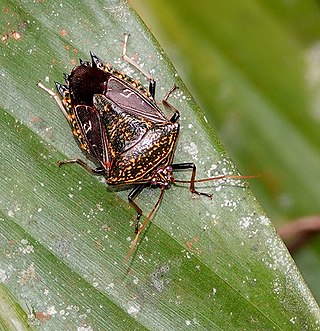
The Pentatomoidea are a superfamily of insects in the suborder Heteroptera of the order Hemiptera. As hemipterans, they possess a common arrangement of sucking mouthparts. The roughly 7000 species under Pentatomoidea are divided into 21 families. Among these are the stink bugs and shield bugs, jewel bugs, giant shield bugs, and burrower bugs.

Pentatomidae is a family of insects belonging to the order Hemiptera, generally called shield bugs or stink bugs. Pentatomidae is the largest family in the superfamily Pentatomoidea, and contains around 900 genera and over 4700 species. As hemipterans, the pentatomids have piercing sucking mouthparts, and most are phytophagous, including several species which are severe pests on agricultural crops. However, some species, particularly in the subfamily Asopinae, are predatory and may be considered beneficial.

Acanthosomatidae is a family of Hemiptera, commonly named "shield bugs" or "stink bugs". Kumar in his 1974 world revision recognized 47 genera; now this number is 55 genera, with about 200 species, and it is one of the least diverse families within Pentatomoidea. The Acanthosomatidae species are found throughout the world, being most abundant in high-latitude temperate regions and in subtropical regions at high altitudes.

Trachyderini is a tribe of long-horned beetles in the family Cerambycidae. There are at least 140 genera and 650 described species in Trachyderini.

Hexacentrus is the type genus of bush-crickets in the subfamily Hexacentrinae. Most species of this genus occur in Southeast Asia and in Africa.

Dinidoridae is a small family of hemipteran "true bugs" comprising about sixteen genera and a hundred species the Hemiptera suborder Heteroptera. As a group the family does not have any common name. Until the late 19th century they were generally regarded as a subfamily of Pentatomidae.

Zicrona is a genus of bugs of the family Pentatomidae. It was circumscribed by Charles Jean-Baptiste Amyot and Jean Guillaume Audinet-Serville

Edessa is a large New World genus of stink bugs in the family Pentatomidae, containing over 250 described species. Several other genera used to be included until recently, such as Pygoda, Ascra, Paraedessa, Doesburgedessa and others.
Thestral is a genus of shield bug found in central Chile. As of 2018, it is monospecific, just consisting its type species T. incognitus.

Pygoda is a New World genus of stink bugs in the family Pentatomidae. It was formerly considered a subgenus of Edessa but was elevated to genus based on morphological traits: species grouped under Pygoda share a distinctive set of features from body, male external genitalia, and male and female internal genitalia that are very different from any other subgenus of Edessa.

Pygoda ramosa is a species of stink bug in the family Pentatomidae. It was first described in 2018 and is found in the canal area in Panamá.

Pygoda poecila is a species of stink bug in the family Pentatomidae. It was first described in 2018 and is found in Central America. Its scientific name is in reference to the mottled body.
Pygoda amianta is a species of stink bug in the family Pentatomidae. It was first described in 2018 and is found in Costa Rica and Panamá. Its scientific name is in reference to the pure green color of the pronotum, scutellum and connexivum, without brown punctures or stains.
Pygoda variegata is a species of stink bug in the family Pentatomidae. It was first described in 2018 and is found in Costa Rica and Panamá. Its scientific name is in reference to the mix of brown, green and yellow of the body.
Pygoda irrorata is a species of stink bug in the family Pentatomidae found in South America. It was first described as Edessa irrorata by William Dallas in 1851 and renamed under genus Pygoda in 2018.
Pygoda civilis is a species of stink bug in the family Pentatomidae found in Ecuador. It was first described as Edessa civilis by Gustav Breddin in 1903 and renamed under genus Pygoda in 2018.
Pygoda thoracica is a species of stink bug in the family Pentatomidae found in Ecuador. It was first described as Edessa thoracica by William Dallas in 1851 and renamed under genus Pygoda in 2018.
Pygoda expolita is a species of stink bug in the family Pentatomidae found in Costa Rica and Panamá. It was first described as Edessa expolita by William Lucas Distant in 1892 and renamed under genus Pygoda in 2018.










